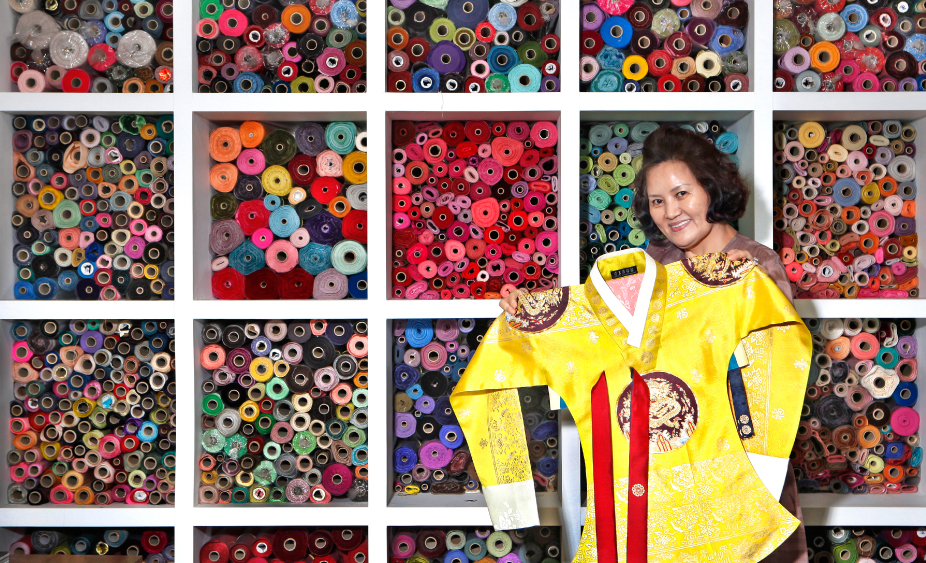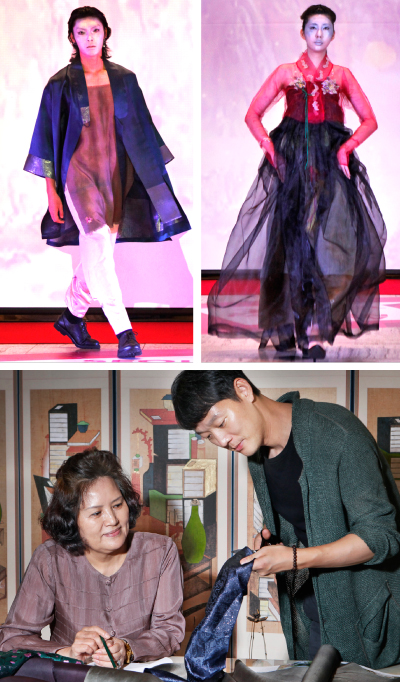[ZOOM KOREA] Hanbok designer creates garment’s future

Designer Baek Oak-soo smiles in front of a variety of brightly colored fabrics that she dyed herself on display at her work-space, Baek Oak-soo Hankook Euisang. [PARK SANG-MOON]
Baek Oak-soo Hankook Euisang, located in Sinsa-dong, southern Seoul, is a store, a workspace and a showroom of fabric and accessories. Here, designer Baek focuses not only on making traditional hanbok but also spends each day studying hanbok designs that can be worn by people all over the world.
Designer Baek says that she used to wear hanbok that were made by her mother on traditional Korean holidays. After getting married, she had the opportunity to deepen her knowledge about the colors of the hanbok that enticed her when she was little, through the lessons she had with her mother-in-law Nam Jung-ho who was a professional natural fabric dyer. To this day, Baek credits her mother-in-law for her outstanding usage of color in her designs.

Models, top, walk down the runway wearing designer Baek’s interpretation of a futuristic hanbok. Baek Oak-soo, above, talks with her son Cho Jin-woo about fabric. [BAEK OAK-SOO HANKOOK EUISANG, PARK SANG-MOON]
All that she could do for her son was fervently pray. Through her prayers Baek slowly started to realize that she had to do something else in order to protect her child. One night, she dreamt that she was held by an old lady who was dressed in exquisite outfit. They were standing in front of a display located in the allies of Dongdaemun and the old lady told her to buy whatever she wanted from the display.
At first, Baek did not understand the meaning of the dream and she prayed to have the meaning come to her. This was when she dreamt about a hanbok. Afterwards, she combined the two dreams together and perceived it as her calling to design hanbok and has been engrossed in designing ever since. Baek was always with her son while she was designing hanbok and says she was at her happiest when she was with her son.
Baek never spent a minute away from her son and credits him as the reason why she was able to be so immersed in her nearly 30-year career. However, Korea’s most talented hanbok designer also has a tragic secret that she has kept to herself. Sadly, the son that she thought was going to be by her side forever, passed away three years ago.

Designer Baek Oak-soo presented an array of hanbok on the theme of the garment’s past, present and future for the “Seoul 365 - Seoul Museum of History Fashion Show“ at the Seoul Museum of History. [BAEK OAK-SOO HANKOOK EUISANG]
Comfort will be why future hanbok wearers choose to wear the garment in their homes or to work. If the color and design is properly coordinated to express a sophisticated style, hanbok could be worn as a more functional and stylish alternative to the average suit.
Baek’s designs reimagine the traditional shape of hanbok. She has made versions of the garment with short pants and has taken the traditional Korean overcoat, into special consideration as a piece that one could wear with pants instead of the traditional skirt.
The hanbok that are commonly seen on runways in Korea are mostly designed by Baek. The wide array of colors that she uses are her trademark. She usually uses strong and vibrant colors instead of pastels because she believes that bright colors deliver a depth to the designs that pastel colors cannot. Her designs are now leading fashion trends in Korea. Just weeks ago, her designs wore worn by internationally-acclaimed K-pop group BTS.

K-pop group BTS, top, wears designer Baek’s hanbok in the “IDOL” music video.
Baek is both a traditional fashion dyer and an experienced fabric shop owner who immersed herself in hanbok designs after being influenced by her mother-in-law. Her youngest son, Cho Jin-woo, who studies Korean traditional clothing has followed in his mothers footsteps and has inherited the family business as the third generation owner.
Baek Oak-soo’s designs are shown in international and national fashion shows, promoting the aesthetics of the hanbok’s beauty to the world.
BY PARK SANG-MOON [moonpark@joongang.co.kr]










with the Korea JoongAng Daily
To write comments, please log in to one of the accounts.
Standards Board Policy (0/250자)